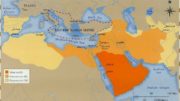There’s a global pandemic right now, but you won’t read about it in our media. It’s claiming thousands of lives, in a dozen countries. I’m talking about the Muslim persecution of Christians. If the situation is so bad, then why is it virtually unknown in the West? Millions of Christians live there, who presumably would want to know about it.
But the powers that be have done everything in their power to conceal it.
In this article, we’ll take an in-depth look at the many tactics the media employ to transform the atrocity, which has led to the slaughter of thousands and the abuse of hundreds of millions, into a non-story.
The primary tactic is outright suppression, as underscored by the recent case of a Muslim man stabbing a Christian priest in the middle of a sermon, captured during a livestreamed event. The video, which is available for viewing on X, has sent the global establishment — spearheaded by Australia, where the attack occurred — into a paroxysm of fury against platform owner Elon Musk.
For merely allowing access to a simple (and by Hollywood standards, very tame) video, the traditional gatekeepers of information wish to see Musk thrown in prison, and the key thrown away. Why? Because he broke a cardinal if unspoken rule: he gave vent to something — the Muslim persecution of Christians — that all media know must be suppressed or distorted at every turn.
I have been documenting that persecution for nearly two decades. So I have ample experiences with outright censorship and am constantly “shadowbanned” on social media. In some nations, most notably Canada, my website is completely banned, while other networks claim it is “pornographic” (even as half-naked women appear in the adjoining ads on permitted sites).
Short of this, the media employ more subtle tactics.
First, they only report on the most sensational attacks — for example, the church bombings that leave dozens of Christians dead or maimed. (This has occurred countless times throughout the Muslim world, and increasingly, the non-Muslim world as well). Even then, the reporting is minimal. U.S. media reported on the killing of a gorilla six times more often than the decapitation of 21 Egyptian Christians who refused to recant their faith.
The strategy is simple: by reporting only on terrorist attacks carried out by banned organizations which are easily and routinely dismissed as “not representing Islam,” and which occur only every few months or so, as opposed to every day, the media creates an illusion: that attacks on Christians are few and far between — and never carried out by true Muslims, who are naturally tolerant, but rather only by “hijackers of Islam.”
In reality, those spectacular terrorist attacks that receive coverage are just the tip of the iceberg of the persecution. Indeed, in July 2011, I decided to begin compiling monthly reports titled “Muslim Persecution of Christians.” I was initially concerned over the feasibility of this project; what sort of “report” could be compiled if, say, only one or two — or even zero — instances of persecution occurred in any given month? Sadly, this has never been the case. Every one of my now 153 monthly reports has contained between one and two dozen atrocities.
The overwhelming majority of these stories never appear on any big media outlets, but rather smaller human rights websites and foreign-language sources. Are they worthy of coverage? Ask yourself: What if Christians were banning or attacking mosques; attacking or imprisoning Muslims for blaspheming Jesus; abducting, raping, and forcibly converting Muslims girls; and enforcing myriad forms of open discrimination against Muslims. Those stories would dominate global media coverage for months, and rightly so.
Which leads to the media’s second strategy: relativizing and neutralizing the events, always trying to present the atrocities as generic “crimes” that have nothing to do with either the victims’ or perpetrators’ religious identity. I have read many reports of terrorist attacks that claim dozens of lives, only to find at the very end (or sometimes by reading between the lines and doing further research), that those slain were targeted for being Christians.
For example, when Muslims bombed three churches in Sri Lanka on Easter in 2019, killing some 300 Christians, many politicians (including former President Barack Obama and Hilary Clinton), could not even bring themselves to identify the victims as “Christians.” Instead, they condemned the “terror” attack on “Easter worshippers.”
Other times, unprovoked Muslim attacks on Christians are portrayed as “sectarian strife,” a phrase that suggests two equally matched adversaries. This hardly describes reality: Tiny Christian minorities being persecuted in Muslim-majority nations. The New York Times’ headline for a story about an Islamic terror attack on an Egyptian church that left 21 worshippers dead in 2011 was “Clashes Grow as Egyptians Remain Angry after an Attack” — as if frustrated and harried Christians lashing out against their persecutors was the really big and troubling news, not the unwarranted slaughter they just experienced.
Similarly, NPR once ran a report on “sectarian violence” in Egypt, accompanied by a large photo of what appeared to be a “fanatical” Christian mob waving a crucifix—not what prompted that particular display of Christian solidarity: the nonstop persecution of Copts in Egypt.
Or consider a 2012 BBC report on a church attack in Nigeria that left three Christians, including an infant, dead. It objectively states the bare-bone facts before jumping to the really big news: “The bombing sparked a riot by Christian youths, with reports that at least two Muslims were killed in the violence. The two men were dragged off their bikes after being stopped at a roadblock set up by the rioters, police said. A row of Muslim-owned shops was also burned…”
The report goes on and on — with an entire section about “very angry” Christians — until one confuses victims with persecutors, forgetting what the Christians are “very angry” about in the first place: nonstop terror attacks on their churches and the slaughter or enslavement of their women and children.
Incidentally, since that 2012 church attack, literally thousands of more churches have been attacked, torched, or bombed by Muslims in genocidal Nigeria, where one Christian is killed every two hours. But the establishment continues to point to anything and everything for “motive” — most recently, climate change, which apparently is “forcing” hapless Muslims to murder Christians.
As should be clear by now, the net effect of such reporting throws the truth upside down: victims are persecutors and persecutors are victims. Nor does one need to look to sub-Saharan Africa for examples; the same thing is happening right here in the USA.
Last March, after a woman claiming to be a man stormed her former Christian school in Nashville and murdered three children and three staffers, the establishment media went into damage control mode (as documented here): They insisted the woman’s motive was “unclear” (while simultaneously refusing to release her manifesto), and hinted that, if anything, the Christians who have made the lives of transgender people a living hell had it coming. And, true to form, many headlines seemed to be intentionally misleading, including Reuters’: “Former Christian school student kills 3 children, 3 staff in Nashville shooting.” Anyone just reading the headline — as many are wont to do — may well conclude that a Christian targeted students in a secular school.
A final and rather deplorable strategy is to actively issue false news in an effort to suppress the specter of Muslim violence against Christians. In the days before the aforementioned 21 Egyptian Christians were decapitated in Libya, the BBC falsely reported that most of them had been “released” (again, nothing to see here; move along).
Meanwhile, as the media continues broadcasting an alternate universe built on lies, the persecution of Christians around the world has nearly doubled since 1993 and continues to spread to nations not formerly associated with the persecution — including India, Mexico, and Nicaragua.
Most Americans, including most self-professed Christians, are either totally unaware of this phenomenon or have no idea of its extent or significance. If the current trajectory does not change, they will likely remain in the dark until the persecution starts to hit much closer to home — by which time accurate reporting will no longer be needed as the persecution will be a lived experience.
SOURCE: RAYMOND IBRAHIM




